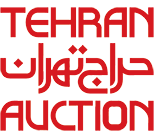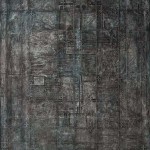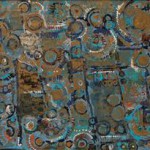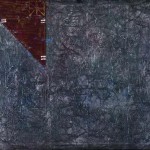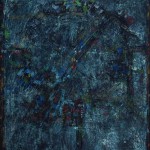Like an architect, Massoud Arabshahi contrives his visual design, using solid yet primitive and emblematic lines to depict his primordial mythological figures on a mysterious background. He is well aware of the qualities and application of layers of color. Arabshahi has an incredible control over the lines he draws. The present painting is a reference both to an ancient cityscape and latticed windows of Islamic architecture.
Massoud Arabshahi’s abstract, symbolic imagery in this work represents a universe on the verge of creation. According to a host of age-old myths, the universe is created out of darkness, and in the process of this tumultuous creation, dazzling rays of light are emitted to turn “nothingness” into “existence” and “absence” into “presence”. In a similar way, during the birth of the most ancient mythological figures, such as Mithra, dazzling light is created from the heart of darkness – it is similar to what we see in Arabshahi’s work. Even though Arabshahi’s works of this type utilize dark colors in the background, they portray a fundamental concept of “birth” and “creation” in a magnificent way by inducing a graphic depth at the moment the spectator is reflecting upon the work. One can observe that the work is illustrating a moment of birth, the moment that gold and khaki grounds and world-forming outlines appear on the canvas. It is not hard to imagine that before such colors were applied to Arabshahi’s canvas, Earth was in absolute darkness and cold. Not only were mankind and plants non-existent at this stage, but none of the natural elements, except earth, existed on Earth before an early mythological figure, such as Mithra, came into being, making Earth glitter in the presence of water, wind and fire.
Early works of Arabshahi were based on Mesopotamian motifs, reaching a universal status in a way that now his works no longer belong to a specific time and place. Hence, he considers himself the architect of a contemporary national style that does not belong to a particular geographical region.
Arabshahi says, “I never tried to assign lines and motifs to a specific time in order to create a conscious divide. A fascination with Sumerian and Assyrian motifs has, no doubt, undergone a remarkable evolution. The evolution of my art is evoking curiosity as much as a methodology and emotional concentration do. A development in the fundamental analysis of mythological works and a thorough understanding of modern art assisted me in recounting the concepts I had in mind as well as initiating a national style. I created my works and produced a mental image by making a clever selection and establishing fresh links between visual elements, without having to rely on narratives. The other major element has been – and still is – time. A majority of my works have their roots in history, while being conspicuously contemporary and up-to-date. In other words, I treated space in a way that it presented a modern visual sphere. Although I exploited archetypal motifs and symbols in my work, they never assumed a static form far from being creative; rather, they have always conveyed a sense of dynamism. Dynamism, motion and time are so evident and innate in my work that no trace of their Western ancestry is found in them.”[1]
[1] From the interview of Mohammad Shamkhani with Massoud Arabshahi in “A Critique of some Pioneers of Iranian Contemporary Art”, Tehran, 2005, 15
